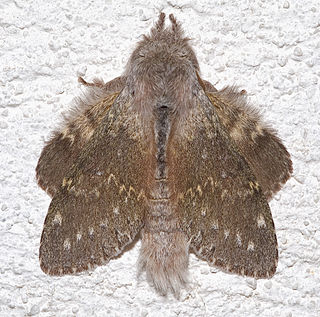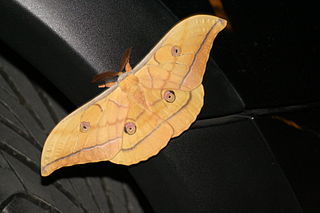
Moths are a group of insects that includes all members of the order Lepidoptera that are not butterflies. They were previously classified as suborder Heterocera, but the group is paraphyletic with respect to butterflies and neither subordinate taxa are used in modern classifications. Moths make up the vast majority of the order. There are thought to be approximately 160,000 species of moth, many of which have yet to be described. Most species of moth are nocturnal, although there are also crepuscular and diurnal species.

The domestic silk moth is an insect from the moth family Bombycidae. It is the closest relative of Bombyx mandarina, the wild silk moth. The silkworm is the larva of a silk moth. The silkworm is of particular economic value, being a primary producer of silk. A silkworm's preferred food is white mulberry leaves, though they may eat other species of mulberry, and even leaves of other plants like the osage orange. Domestic silk moths are entirely dependent on humans for reproduction, as a result of millennia of selective breeding. Wild silk moths are not as commercially viable in the production of silk.

Lymantria dispar, also known as the gypsy moth or the spongy moth, is an Eurasian species of moth in the family Erebidae. Lymantria dispar is subdivided into several subspecies, with subspecies such as L. d. dispar and L. d. japonica being clearly identifiable without ambiguity. Lymantria dispar has been introduced to several continents and is now found in Europe, Africa, Asia, North America and South America. The polyphagous larvae live on a variety of deciduous and coniferous trees and can cause severe damage in years of mass reproduction. Due to these features, Lymantria dispar is listed among the world's 100 worst invasive alien species.

Ypsolophidae is a family of moths with some 160 species. They are included in the Plutellidae by many authors.

Ptilodoninae is a subfamily of the moth family Notodontidae. They are sometimes merged into the Notodontinae. The genus list is preliminary, as not all Notodontidae have been assigned to subfamilies yet.

The lobster moth, also known as lobster prominent, is a moth from the family Notodontidae. The species was first described by Carl Linnaeus in his 10th edition of Systema Naturae. The English name refers to the crustacean-like appearance of the caterpillar.

Abraxas sylvata, the clouded magpie, is a Palearctic moth of the family Geometridae that was named by Giovanni Antonio Scopoli in 1763.

Eupoecilia ambiguella, the vine moth, is a moth of the family Tortricidae. It is found in Europe, China, India, Japan, Korea, Mongolia and the Russian Far East.

Spoladea recurvalis, the beet webworm moth or Hawaiian beet webworm moth, is a species of moth of the family Crambidae. It is found worldwide, but mainly in the tropics.

Ptilophora plumigera, the plumed prominent, is a moth of the family Notodontidae. The species was first described by Michael Denis and Ignaz Schiffermüller in 1775. It is found in the southern parts of the Palearctic realm.

Antheraea yamamai, the Japanese silk moth or Japanese oak silkmoth is a moth of the family Saturniidae. It is endemic to east Asia, but has been imported to Europe for tussar silk production and is now found in southeastern Europe, mainly in Austria, northeastern Italy, and the Balkans. It seems to be spreading north and a population has been reported near Deggendorf and Passau in Germany. The species was first described by Félix Édouard Guérin-Méneville in 1861. It has been hybridized artificially with Antheraea polyphemus of North America.

Ptilophora is a genus of moths of the family Notodontidae The genus was described by Stephens in 1828.
Ptilophora nanlingensis is a moth of the family Notodontidae. It is known from Guangdong in China.
Ptilophora ala is a moth of the family Notodontidae. It is known from Shaanxi and Sichuan in China.
Ptilophora horieaurea is a moth of the family Notodontidae. It is known from Sichuan in China.
Ptilophora rufula is a moth of the family Notodontidae. It is known from Taiwan.
Ptilophora jezoensis is a moth of the family Notodontidae. It is known from Japan and the Russian Far East.

Brachmia dimidiella is a moth of the family Gelechiidae. It is found in most of Europe, east to Japan.
This page is based on this
Wikipedia article Text is available under the
CC BY-SA 4.0 license; additional terms may apply.
Images, videos and audio are available under their respective licenses.











